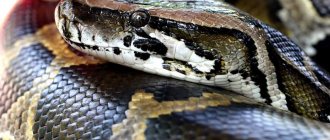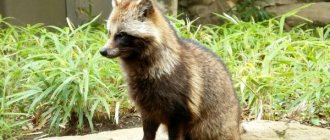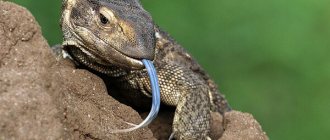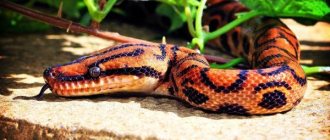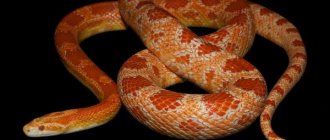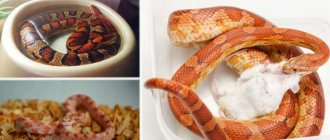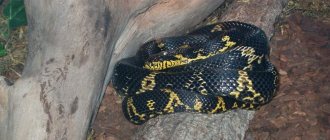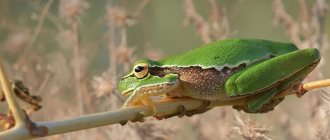Snakes show their independence with all their appearance. They are able to live in the wild without any human intervention at all. Cold, independent animals, despite all the horror that they inspire in humans, are actually considered one of the most beautiful creations of nature. Among the snakes there are truly giants, such as the anaconda or the python.
The python has long won the love of humans; it is readily kept at home; circus performers often use this type of snake in their acts, delighting adults and children. Snake lovers fell in love with the reptile for its non-conflict disposition and minimal aggressiveness. But do not forget that the python is first and foremost a predator, and you need to behave with extreme caution with it.
What does it look like
It is difficult to identify the predominant color of Python molurus. The final color of each individual depends on many factors. For example, depending on the type of snake.
Usually, dark (for example, brown) spots are located on a lighter background with a yellowish tint. The latter can be of different shapes and sizes. Together, the spots on the snake’s skin form a complex and individual pattern. As a result, it becomes like the skin of a tiger or leopard. This is what explains the name python in the first place.
A dark stripe runs through the reptile's eyes. It starts its path approximately from the nostrils and reaches the spots on the neck. Another stripe goes from the eyes downwards and turns bizarrely, touching the upper lip of the reptile. On the top of the snake's head there is a dark spot, somewhat blurred in front. It is shaped like an arrowhead.
In the middle of the side spots there may be lighter “eyes”. Quite bright stripes with a red or pink tint are clearly visible on the sides of the head. Interestingly, such albinos tiger pythons can also be found in nature.
What does a tiger python eat?
Photo: Albino tiger python
The diet consists mainly of live prey. Its main products are rodents and other mammals. A small part of its diet consists of birds, amphibians and reptiles.
The range of prey ranges from mammals and birds to cold-blooded lizards and amphibians:
- frogs;
- bats;
- deer;
- small monkeys;
- birds;
- rodents, etc.
When searching for food, the tiger python can stalk or ambush prey. These snakes have very poor eyesight. To compensate for this, the species has a highly developed sense of smell, and each scale along the upper lip contains indentations that sense the warmth of nearby prey. They kill prey by biting and squeezing until the victim suffocates. The affected victim is then swallowed whole.
Fun fact: In order to swallow prey, the python moves its jaws and stretches the highly elastic skin around the prey. This allows snakes to swallow food many times larger than their own heads.
Studies of tiger pythons have shown that when digesting a large food animal, a snake's heart muscle can increase by 40%. The maximum increase in heart cells (hypertrophy) is achieved after 48 hours due to the conversion of proteins into muscle fibrils. This effect promotes an energetically more favorable increase in cardiac output, which speeds up digestion.
In addition, the entire digestive system adapts to digestive conditions. This is how the intestinal mucosa increases up to three times two days after feeding. After about a week, it shrinks to its normal size. The entire digestion process requires up to 35% of the energy absorbed from prey.
Length and weight
Despite the fact that the snake in question is non-venomous, it is capable of instilling terror in others with its mere appearance. This is a very large reptile, the length of which on average ranges from 1.7 to 3.8 m. The impressive size does not frighten many modern lovers of exotic animals, including snakes; people keep tiger pythons even in small city apartments, terrifying their neighbors .
The longest python discovered to date exceeded 4.5 m. Moreover, its weight was more than 50 kg. Interestingly, females always turn out to be somewhat more massive than males.
Population and species status
Photo: Snake tiger python
Commercial exploitation of the tiger python for the leather industry has led to significant population declines in many of its range countries. In India and Bangladesh, the tiger python was widespread around 1900. Excessive hunting followed for over half a century, with up to 15,000 pelts exported annually from India to Japan, Europe and the United States. In most areas this has led to a massive decline in the number of individuals, and in many places even to complete extinction.
In 1977, exports from India were banned by law. However, illegal trade continues today. The tiger python is now rarely seen in India outside of protected areas. In Bangladesh, the range is limited to a few areas in the southeast. In Thailand, Laos, Cambodia and Vietnam, the tiger python is still widespread. However, the use of these species for the leather industry has increased significantly. In 1985, it peaked at 189,068 hides officially exported from these countries.
The international trade in live tiger pythons also peaked at 25,000 animals. In 1985, Thailand introduced a trade restriction to protect tiger pythons, meaning that only 20,000 skins could be exported annually. In 1990, tiger python skins from Thailand averaged just 2 meters in length, a clear sign that reproductive numbers had been massacred. In Laos, Cambodia and Vietnam, the leather industry continues to contribute to the ongoing decline of the python.
Reptile subspecies
Initially, the dark and light tiger pythons were considered one species. Now the first one is separated into a separate view. The dusky tiger python (Python bivittatus) has the maximum distribution. You can recognize it by several signs. First of all, such a snake does not have “eyes” on the side in the drawings. This is one of the main differences.
The dark reptile is characterized by larger parameters. In an apartment, with minimal movement and quality nutrition, it can grow on average up to 6 meters. In its natural habitat - up to about 5 meters. This tiger python has darker tones in color.
For example, it is often dark brown or olive brown. On the surface of the head you can see a clear stripe shaped like a diamond. This species lives primarily in South and Southeast Asia.
As for the light tiger python, there are two subspecies. The first one was called “Indian”. Its lateral spots usually have light “eyes.” The color is in shades of brown, but lighter than that of the species described above. The arrow on the head of such snakes is slightly blurred. The maximum length of individuals is 5 meters.
The second subspecies is called “Ceylon”. It is more rare and comes to Russian reptile lovers from Sri Lanka. The head of such snakes has the lightest possible color, and the “arrow” on it is very blurred. But the body color turns out to be brighter. The size of the tiger python usually ranges from 2.5 to 3.5 meters.
Author: Alexey Poyarkov “Reptomix Laboratori” Published: Aqua Animals magazine 2006/4
When choosing a reptile for home keeping, novice terrarium keepers usually do not consider the possibility of purchasing pythons, preferring smaller or brighter representatives of the scaly world (such as chameleons, iguanas, geckos, etc.) without knowing what problems they may encounter without having sufficient maintenance experience in the future. After all, the bulk of reptiles offered on the Russian market are imported from their native countries, practically from nature, in the best case from farms and breeding grounds also located in the open air, where they are kept and bred practically on free grazing, and the sanitation and quarantine of animals are not maintained. at the proper level. Hence the rather low prices for imported animals (animals bred in captivity usually cost an order of magnitude more expensive, due to better health and appearance, high-quality breeding and smaller batches; such animals usually end up with animal lovers in Europe and the USA because they are already there a market has developed and more stringent requirements are imposed on imported wildlife objects), insufficient quarantine, or even simply pre-sick animals end up in the terrariums of newcomers in Russia. Ignorance of the conditions of detention and lack of information about reptiles also leads to illness and, as a result, death in novice terrarium keepers. Hence the declining interest in keeping reptiles in general, they say it is an expensive, complex and murky business... In fact, everything is different if the animal is purchased from breeding from a reliable manufacturer.
When I am asked the question of who should a novice terrarium hobbyist get? I usually name no more than a dozen species, the first lines of which include the Dark Tiger Python Python molurus bivittatus, the most, in my opinion, problem-free animal for a novice terrariumist. I will give only small arguments; We breed quite a lot of them, there is no point in exporting it, which means their health is fine, and the proper appearance of an exotic animal is present in it, there are several color options, it is not demanding in care and feeding, it is kind in nature, it gets used to hands quickly, which means you can surprise ignorant friends and acquaintances. It’s not for nothing that circus performers and photographers chose these animals for their work. In Europe and the USA, the tiger python is among the top three reptiles for home keeping, after the red-eared turtle and iguana, and in the countries of Southeast Asia it is generally almost domesticated and is used in free-range areas as a domestic cat to kill rodents. So who are these tiger pythons?! Three subspecies of these reptiles are known: this is the Indian light tiger python Python molurus molurus, a medium-sized snake, usually not exceeding 4 meters, but six-meter specimens are also known. Distributed in Pakistan, India, Bangladesh. The coloring of this subspecies is lighter than the other two. Due to the intensive development of natural habitats, the range of the Indian python has sharply decreased. Currently, pythons are found in protected and national parks in the south and southeast of India. The Indian light tiger python is protected by law, included in the national and international Red Data Books, and in the first appendix of CITES lists. It is bred in captivity, but is extremely rare in amateur terrariums. Ceylon tiger python - Python m. Pimbura is the smallest of the tiger pythons. Usually its length does not exceed 2 - 3 meters. Outwardly similar to the light tiger python, with which it was previously united into one subspecies. In addition to size, it differs from the Indian python in the shape of its head. Python m. pimbura is endemic to the island of Ceylon (Sri Lanka), inhabiting the few forests and jungles that have remained intact. Included in the national and international Red Books, and in the second appendix of CITES lists. Due to its small size, it is a desirable species for terrarium lovers to keep, but it is quite expensive and rare, bred in captivity. And finally the Dark Tiger Python - P. m. bivittatus is the largest, brightest, and most common python from this group in the collections of zoos and terrarium keepers. It is darker in color than other subspecies (hence the name), inhabits mountain rain forests (it is called the “mountain Burmese python”) of Southern China, Vietnam, Cambodia, Northern Thailand, Laos, Burma. The mountains rise to 1800 m above sea level. It reaches a length of up to 7 m, but in a terrarium it is usually about 4-5 m, and some of its morphs are even smaller. P. m. bivittatus is included in the second appendix of CITES listings. Currently, there are quite a lot of morphs and color variations of this python in the world, such as “Albino”, “Albino Green”, “Albino Labyrinth”, “High Orange Albino”, “Axantic”, “Blonde”, “Brindle”, “ Fader", "Granite", "Labyrinth", "Leopard", "Leucistic", "White". The most famous in Russia are the albino form “Albino”, and the less common “Green Patternless”, the “Granite” form is occasionally released by python breeders, and the “High Orange Albino” form is very rare.
Young dark tiger python P. m. bivittatus variations “Green Patternless”, these morphs of pythons are still quite rare in the collections of terrariumists in Russia.
Albino coloration of the dark tiger python P. m. bivittatus “Albino” Next we will talk about keeping and breeding the most common subspecies of the dark tiger python and all its morphs and variations. Tiger pythons are kept in horizontal terrariums. The dimensions of the terrarium must correspond to the size of the animal. Climbing branches are desirable (especially for young pythons), but not required. It is necessary to arrange a small pool or drinking bowl in the terrarium, but such that the animal cannot knock it over. Pythons love to lie in water, especially during molting. In order for the animal to choose the optimal temperature conditions for heating or cooling, the terrarium must have two zones: heated and unheated. In the heated zone of the terrarium, it is necessary to equip lower and upper local heating; the lower heating must have an area no less than the area of the coiled python and be connected through a thermostat. For overhead heating, you can use any heat source (sometimes even a mirror lamp of no more than 100 W is enough, the power of the lamp depends on the volume of the terrarium and is selected experimentally). The overall optimal air temperature in the terrarium is 24-25*C, with heating the temperature during the day is 30-31*C, and at least 28*C at night. Bottom heating must be turned on 24 hours a day. In the terrarium you need to think about good ventilation. As a ground for pythons, you can use paper or a more aesthetically pleasing “artificial grass” mat. It is necessary to maintain cleanliness in the terrarium; after each defecation of animals (which, by the way, are quite rare, no more than once every 7-10 days), it is necessary to change the bedding or hygienically wash the rug. It is advisable and useful in the warm season in sunny weather at temperatures not lower than 25*C to give pythons walks outside, 2-3 times a week for 15-30 minutes to receive a dose of ultraviolet rays. It is not advisable to specifically install a UV lamp in a terrarium, since in nature animals lead a nocturnal and sedentary lifestyle, hiding during the day in dark places or places that are not easily accessible to the sun. (burrows, snags, rock crevices, leaf litter, etc.) and only occasionally crawling out into the sun to warm up. Young pythons are fed once every 7-10 days, adults once every 10-20 days, with food items of appropriate size: mice, rats, guinea pigs, rabbits, poultry. Typically, pythons are not picky eaters and will absorb any food given to them that is suitable in size, although sometimes there are exceptions that specialize in one food preference, for example poultry, so when purchasing an animal you need to inquire about its taste preferences. Sometimes teenage pythons and adult animals can refuse food and starve for 1-6 months without harm to their health. This is due to the imitation of natural seasonality, wintering, skin change, sexual behavior, etc. If at the same time the animal begins to lose weight, it is better to consult a veterinarian.
Python P. m. bivittatus eating a rat. After 3-7 feedings, pythons usually begin to molt. At the same time, their color becomes dull, their eyes and skin become cloudy, as if covered with milky whiteness... Usually, molting lasts 1-2 weeks. At this point, animals may refuse food, and it is better not to feed them. During this process, the terrarium and the animal must be moistened abundantly. Usually, immediately before changing the skin, the python’s color again becomes transparent, as if “lightening.” After changing the skin, the crawler must be removed from the terrarium to prevent the development of unwanted pathogenic flora that causes mycosis of reptiles. The humidity in the terrarium after molting can be reduced. Immediately after molting, animals can be offered food. Pythons grow quite quickly and reach maturity by 2.5-3 years with a size of 2-3 m. After imitating natural seasonal changes, pythons develop sexual behavior. When sexual partners are ready, mating is usually observed within 1-4 hours after mating. At the same time, the female raises her tail upward, and the male, scraping the rudiments of the hind limbs with his claws, entwines the female’s tail.
Python mating female P. m. bivittatus male P. m. bivittatus “Albino”, with this mating, “heterozygous” babies are obtained, their coloring will be like natural ones, but each of them will contain the “Albino” gene of the male. With subsequent crossing between each other (according to the law of genetics), it is possible to obtain pure lines of P. m. bivittatus "Albino".
Mating of pythons P. m. bivittatus and P. m. bivittatus "Albino", the rose-shaped hymepenis of the male is clearly visible in its swollen state. The duration of mating will last from 20 minutes to 2 hours. After successful mating, the partners are seated. After mating, the female can eat 1-2 more times, after which she refuses food for the entire period of pregnancy and incubation of eggs. The male may also not eat throughout the entire sexual period. Usually, 2-3 weeks after mating, the female ovulates, during which process she turns on her side or back and lies motionless for several hours. Usually this process confirms the successful productive mating of partners. Pregnancy lasts about 60 days. Before laying eggs, the female becomes restless and looks for a place suitable in temperature and humidity. A month before the female lays eggs in the terrarium, it is advisable to place a nest house with a side or top entrance with hygroscopic moist soil (shavings, sphagnum moss or coconut chips). The size of the house is selected so that it can fit in it along with the masonry. Laying usually begins at night (see photo 7). From the beginning of laying the first egg to the completion of the clutch, 12-48 hours usually pass. On average, the female lays from 15 to 50 leathery, oblong white eggs measuring 110*75 mm (see photo 8). Pregnancy itself, the process of laying eggs as well as incubation of the clutch, is very difficult for the female and exhausts her strength, she becomes lethargic and physically exhausted, and if done incorrectly, it can even lead to death, so we must try to create more comfortable conditions for her and protect the female from unnecessary stress (extra vibration, bright and harsh light, etc.), and disturb the female with your presence as little as possible.
Oviposition by female P. m. bivittatus, at the moment of laying eggs the female falls into a trance.
Female P. m. bivittatus "Albino" at the time of laying
Female P. m. bivittatus "Green Patternless" at the time of laying The eggs can be left under the female in the terrarium or placed in an incubator. After laying eggs, the female wraps herself around the clutch, guards and incubates it for 59-60 days. At the same time, she herself regulates the temperature of incubation of eggs, either tightly wrapping the eggs and rhythmically contracting the muscles of the whole body for heating, or, on the contrary, opening the clutch for ventilation and cooling. At the moment of incubation, the female becomes more aggressive and excitable. If the clutch is placed in an incubator, then the incubation temperature is 29-32 *C. It should be noted that the yield of young pythons from eggs left under the female is much less than from eggs placed in an incubator. After the first hatching of the eggs, the young still remain in the egg for up to a day and a half (see photos 9 and 10). In general, the time to emerge from the masonry takes about 3 days (see photo 11). After hatching from the eggs, young pythons are about 40 cm in size and are quite independent. For ease of observation and feeding of young pythons, it is better to seat them one at a time. After 7-10 days they moult and can be fed. The first food is adolescent mice or blind rat pups.
One of three trays with python eggs P. m. bivittatus. Selecting and laying eggs in this way saves space in the incubator, but these manipulations should only be carried out by an experienced terrariumist
The first cuts of young pythons P. m. bivittatus
The emergence of pythons P. m. bivittatus a day after the first cuts.. I hope that the popularity of these exotic animals in our country will steadily grow from year to year.
The material is published with the permission of the author.
Keeping at home
Keeping a tiger python at home is not easy and quite expensive. To avoid problems in the process, the breeder must accustom the reptile to itself from a very early age.
Experts do not recommend taking a snake as an adult. Especially - taking it to you already grown up from another breeder to whom the reptile is accustomed.
Otherwise, serious problems may arise in her “upbringing”.
In order for a snake to get used to the smell of its owner and consider it close and safe, a person will first need to have contact with it as often and as much as possible. For example, regularly participate in feeding.
Pythons rarely bite. But some factors may push them to take such actions. For example, fear. Young and nervous snakes often try to bite the owner at first when he takes them out of the terrarium with his hands.
It is very important to behave correctly in such cases. If, after the first attempt to bite, the owner of the reptile is afraid of its reaction and throws the pet back into the enclosure, then the snake will understand that it is easy to drive away the owner by demonstrating its aggression.
In subsequent attempts to establish contact, she will most likely behave in exactly the same way. Therefore, a person must demonstrate his strength and fearlessness in every possible way. You need to remove the snake from the terrarium in a calm environment.
In general, the reptiles discussed are quite calm and peaceful. They easily make contact if the owner behaves correctly. To make a snake’s life comfortable, you need to carefully take care of its nutrition, properly arrange the terrarium, study information about the necessary care during the molting period, etc.
Natural enemies of tiger pythons
Photo: Tiger python
If tiger pythons sense danger, they hiss and crawl away, trying to hide. Only when driven into a corner do they defend themselves with powerful, painful bites. Only a few snakes quickly become irritated and go to extreme measures. There were rumors among local residents that pythons attacked and killed children left unattended. However, there is no serious evidence for this. Reliable cases of death are known in the United States, where owners sometimes suffocate from the “embrace” of a tiger python. The reason was always careless care and handling, which could trigger the hunting instinct in the animal.
The Tiger Python has many enemies, especially when it is young.
These include:
- King Cobra;
- Indian gray mungo;
- felines (tigers, leopards);
- the Bears;
- owls;
- black kite;
- Bengal monitor lizard.
Their favorite hiding places are earthen caves, rock crevices, termite mounds, hollow tree trunks, mangroves and tall grass. Besides animals, humans are the main predator of the tiger python. There is a large export volume for the animal trade. Indian python skin is highly prized in the fashion industry due to its exotic appearance.
In its native range it is also hunted as a food source. For centuries, tiger python meat was eaten in many Asian countries, and eggs were considered a delicacy. In addition, the animal's innards are important to traditional Chinese medicine. The leather industry is a sector that cannot be underestimated in some Asian countries, where professional hunters, tanners and traders work. Even for farmers this is an additional income.
Feeding and care
It is very convenient for owners that such pets do not require frequent feeding. After its next meal, the owner of the snake can forget about this responsibility for about a week. When a python grows to adulthood, it is fed even less frequently - once every 10–11 days. To start with, live or frozen mice are suitable as a main treat. It is very important to feed such snakes with animal food.
For young animals that have just hatched from eggs, experts recommend taking very small rats or mice. When a python grows to 1 meter, you can begin to include adult mice in its menu. After reaching a size of 3 meters, even large rodents can be used for feeding. Special supplements with a high content of vitamins and minerals will also be useful.
It often happens that in the period after the age of 1 month and up to six months, the tiger python suddenly begins to deliberately starve. It is very important to find the reason for such a “strike”. Most often this occurs due to hibernation, molting or pregnancy. If the refusal of food is natural, then the snake will not lose weight. When its volumes nevertheless decrease, you should definitely contact a veterinarian.
It is very important to properly set up a terrarium for your reptile. It must be horizontal and at least 70 cm high. The length and width depend on the size of the snake. The following parameters are considered optimal: 200 by 100 cm. The specified height is convenient for all python care activities. For example, for regular cleaning.
For adults, you should not take a “house” made entirely of glass. They can easily break such a structure by pressing their nose and tail into opposite ends and springing back. The best option is a terrarium made of combined materials. For example, a combination of plastic, glass and wood. The reliability of the locks is no less important. The tiger python is able to open even the most durable lids with ease. But we must not forget about ventilation. Usually, just small holes in the walls of the structure are sufficient.
Torn newspapers or wood sawdust work well as bedding for the bottom of a snake’s home. Today you can buy special mats for snake terrariums in pet stores. They do not need to be changed often, just wash/wash them regularly. But sawdust or newspapers must be replaced with new ones as they become dirty.
The species of pythons under discussion is most comfortable living in high humidity. Optimal parameters are from 60 to 90 percent. Frequent spraying of the terrarium or a special rain installation will help achieve this indicator. It is advisable to place a capacious drinking bowl or even a miniature pool in the python’s home, in which it will bathe regularly. But any container with liquid must be very stable, otherwise the snake will constantly turn it over.
Be sure to give your python a “walk” in the fresh air.
But this does not mean that he needs to be taken outside. It is enough to let the reptile into the room on a sunny, warm day. The air temperature in the room should not fall below 25 degrees.
If the snake is young and nervous, for the first walks you should provide a shelter in which it will feel completely safe. Later you can do without such a shelter.
Feeding a pet python
The feeding process is quite simple . The reptile is capable of not eating for several days; if the owner does not have the opportunity to feed the pet, nothing bad will happen. The level of hunger is regulated by special sensors, which greatly simplifies its maintenance.
Adults are fed with so-called food items. Rodents, such as mice, can act as objects. There is a lot of controversy over whether to feed a python live or dead prey. Some breeders believe that a live rodent can cause injury to the reptile, so the object is killed before feeding. But do not forget that in the natural environment a snake eats its prey alive.
As the snake grows, one object will not be enough . There will come a time when the reptile will have to feed several objects at a time. Therefore, experts recommend replacing small mice with rabbits.
Python is an exotic pet, so you should definitely consult with a specialist before purchasing. And be sure to decide for yourself whether the owner is ready for these snakes to grow to 7-9 m.
Reproduction and moulting
If the tiger python is properly cared for, it will reproduce remarkably even in an ordinary city apartment. Females of this type of reptile reach sexual maturity at approximately 2.5–3.5 years. The mating season lasts from mid-autumn to the end of winter. To speed up the fertilization process, you can arrange an artificial January in the snake’s home by lowering the temperature, humidity level, and reducing light.
During mating, a pair of snakes settles in the same terrarium. After about 2–5 months, the female lays about 50–60 eggs. The number of babies eventually hatched will depend on many factors. For example, on the size and age of the mother. After laying eggs, the female curls up around them and remains in this position for about 2–2.5 months. When the time comes, baby snakes hatch, the length of which does not exceed 45–55 cm.
The molting period is considered no less important for the python. You can get ahead of its onset by the appearance of the snake. Its color fades, its eyes become whitish and cloudy. The whole process takes about 2 weeks. It is recommended not to feed the reptile during this time. It is also important to increase the level of humidity in the home. For example, increase the frequency of spraying the snake itself and the walls of its terrarium with warm water.
The ideal option is to remove the old skin with a whole stocking. But such a result is not always achieved. When the snake's skin lacks moisture, it can come off in separate pieces. It must be removed from the terrarium immediately. When the process of shedding the old “clothes” is completed, you can return the reptile’s feeding, as well as the previous level of humidity.
Features of character and lifestyle
Photo: Great tiger python
The tiger python snake is absolutely not a social animal that spends most of its time alone. Mating is the only time these snakes occur in pairs. They begin to move only when food becomes scarce or when they are in danger. Tiger pythons first detect prey by smell or by sensing the body heat of the victim with their heat pits, and then follow the scent. These snakes are mostly found on the ground, but sometimes climb trees.
Tiger pythons are active mainly at dusk or at night. Daytime initiative is closely related to ambient temperature. In areas with significant seasonal temperature changes, they seek shelter with a more pleasant, more consistent microclimate during the cool and hot months.
Interesting fact: In areas with lakes, rivers and other bodies of water, representatives of both subspecies live a semi-aquatic life. In water they move much faster and more dexterously than on land. While swimming, their body, with the exception of the tip of the snout, is completely immersed in water.
Often tiger pythons are partially or completely submerged for several hours in shallow water. They remain completely underwater for up to half an hour, without inhaling air, or only stick their nostrils to the surface of the water. The tiger python appears to avoid the sea. During the colder months, from October to February, Indian pythons remain hidden and typically enter a short period of hibernation until temperatures rise again.
Required temperature in the terrarium for an individual
One of the most important aspects of caring for a tiger python is maintaining the temperature regime in its “home”. Ideally, it is necessary to create two zones at once - with and without additional heating. But the temperature transition between them must be made very smooth, otherwise the snake may get sick. Thermal mats are well suited for lower heating, which should be constant, and mirror lamps are suitable for upper heating. During the day, the temperature of the heating zone should be 34–36 °C during the day and 28–29 at night. On average, it is necessary to maintain a temperature of 25–26 degrees.
Appearance of the Burmese python
Burmese pythons are known to be one of the largest species of snakes in the world. These snakes can often reach 23 feet in length (though it is more typical to reach lengths of 15 to 20 feet), and they can weigh up to 200 pounds. One of their most striking characteristics is their girth, which can be as wide and thick as a telephone pole. However, when they are born as babies, Burmese pythons are only about two feet long.
Burmese pythons are tan in color and have dark spots on the back and sides of the body, mimicking the same pattern commonly found on
a giraffe .
These spots, however, are unevenly spaced on the skin and can often look like pieces of a puzzle put together. Burmese pythons, which are found in Florida, typically reach a length of only 6-10 feet, and adults can reach the same size as native snakes. Albino Burmese pythons are known to be the most popular.
Burmese python hanging on a tree waiting for prey.
Interesting facts about the large snake
There is very interesting information about tiger pythons that will be useful to know for every person who has decided to place such a reptile in captivity at home:
- The presented snakes never bite the victim they have decided to make their lunch. They entangle it with their body and squeeze until the animal stops breathing. Only the reptile completely swallows already dead prey.
- Under natural conditions, the snake’s favorite “delicacy” is caimans, antelopes and monkeys.
- Today, people actively hunt pythons for their beautiful skin, from which they make a variety of wardrobe items. Most often - bags and wallets.
Tamed individuals, who grew up at home from birth, always turn out to be less aggressive and more friendly than their “wild” counterparts.
Origin of the species and description
Photo: Tiger python
The taxonomy of the tiger python has been the subject of debate for over 200 years. Two subspecies are now recognized. Based on recent research, species status is debated for two forms. Adequate research on tiger pythons has not yet been completed. However, previous observations in India and Nepal indicate that the two subspecies live in different, sometimes even the same, locations and do not mate with each other, hence each of the two forms is proposed to have significant morphological differences.
Video: Tiger Python
On the Indonesian islands of Bali, Sulawesi, Sumbawa and Java, several geographical and morphological aspects of animals have led to significant changes. These populations are more than 700 kilometers from mainland animals and show differences in character and have formed dwarf forms in Sulawesi, Bali and Java.
Due to differences in size and coloration, scientists want to delineate this dwarf form as a separate subspecies. Molecular genetic studies on the status of this dwarf form are still controversial. It remains unclear how deeply other Indonesian island populations differ from mainland populations.
Another of the supposed subspecies is found exclusively on the island of Sri Lanka. Based on coloration, pattern, and the number of shields on the underside of the tail, it shows differences from the mainland subspecies. However, most experts consider the difference to be insufficient. Tiger pythons in this region reflect the expected range of variation among individuals in the population. After a molecular genetic study, it became clear that the tiger python is closest to the Hieroglyphic python.
How much does a non-venomous python cost?
Such a large non-venomous snake has a fairly high cost. Today, its minimum price from non-professional breeders starts from 10 thousand rubles. And you should also remember that you will have to purchase a terrarium, heating devices and many other goods necessary for a comfortable life for a reptile in an apartment.
If there are small children in the house, experts do not advise taking risks and getting a tiger python. In general, these reptiles are safe, but there is always a threat that they will suddenly, for some unknown reason, show aggression and attack.
Burmese python Scientific name
Burmese pythons are known by
the scientific name Python bivittatus
.
They belong to the animal kingdom and the phylum Chordata. The class is called Reptiles, and the order is Squamates. Meanwhile, the suborder is called Serpentes and the family is Pythonidae. The genus is called Python
and the species
is P. bivittatus
, which is the same as the scientific name.
The word “bivattatus” comes from the Latin translation, which means “having two stripes or stripes.” Given the structure of the Burmese python's scales, it is easy to see how this description fits them well.
Predators and threats of the Burmese python
Because they are massive in size, these pythons do not have many predators.
However, some alligators and humans tend to turn into some of the predators they have.
Human activities such as industrialization and urbanization also negatively impact the local population of these pythons. These snakes are currently endangered because their habitat is depleted and the demand for them as pets or even as delicacies in the kitchen is too high. People hunt them for authentic Burmese python skins, which is why their demand in the market remains so high.
Basic diet for a snake
The amount of food for a brindle python increases as it grows. But first, the snake owner needs to decide on the feeding method. Live food can activate its hunter instincts in a reptile, which will be dangerous for humans. At the same time, the snake's victims can injure it when they defend themselves. You can avoid these problems with frozen food. The pet will not be bloodthirsty and will not get injured while hunting in the terrarium.
Young individuals are fed once a week, and adults - once every 10-14 days. Small pythons are given one mouse each. When the length of the snake reaches 1.5 m, it is fed:
- rats;
- rabbits;
- guinea pigs;
- hamsters;
- or chickens.
Reptiles longer than 2 m are given chickens and adult rabbits. It is recommended to include special supplements in the pythons' diet that contain vitamins and calcium.
We must not forget about the water, which must be changed regularly in the drinking bowl. Since the python feels great in an aquatic environment, you can arrange a mini-pool for it, which should be heavy, strong and stable. The lightweight design can be turned over by a pet. Drinking a large volume of water also helps maintain high humidity in the tank.
Reptiles longer than 2 m are given chickens and adult rabbits. It is recommended to include special supplements in the pythons' diet.
